AWM137 2/1 - Historical information and general development of the RAAF Nursing Service - Notes of History of the RAAF Nursing Service 1940-1944 - Part 6

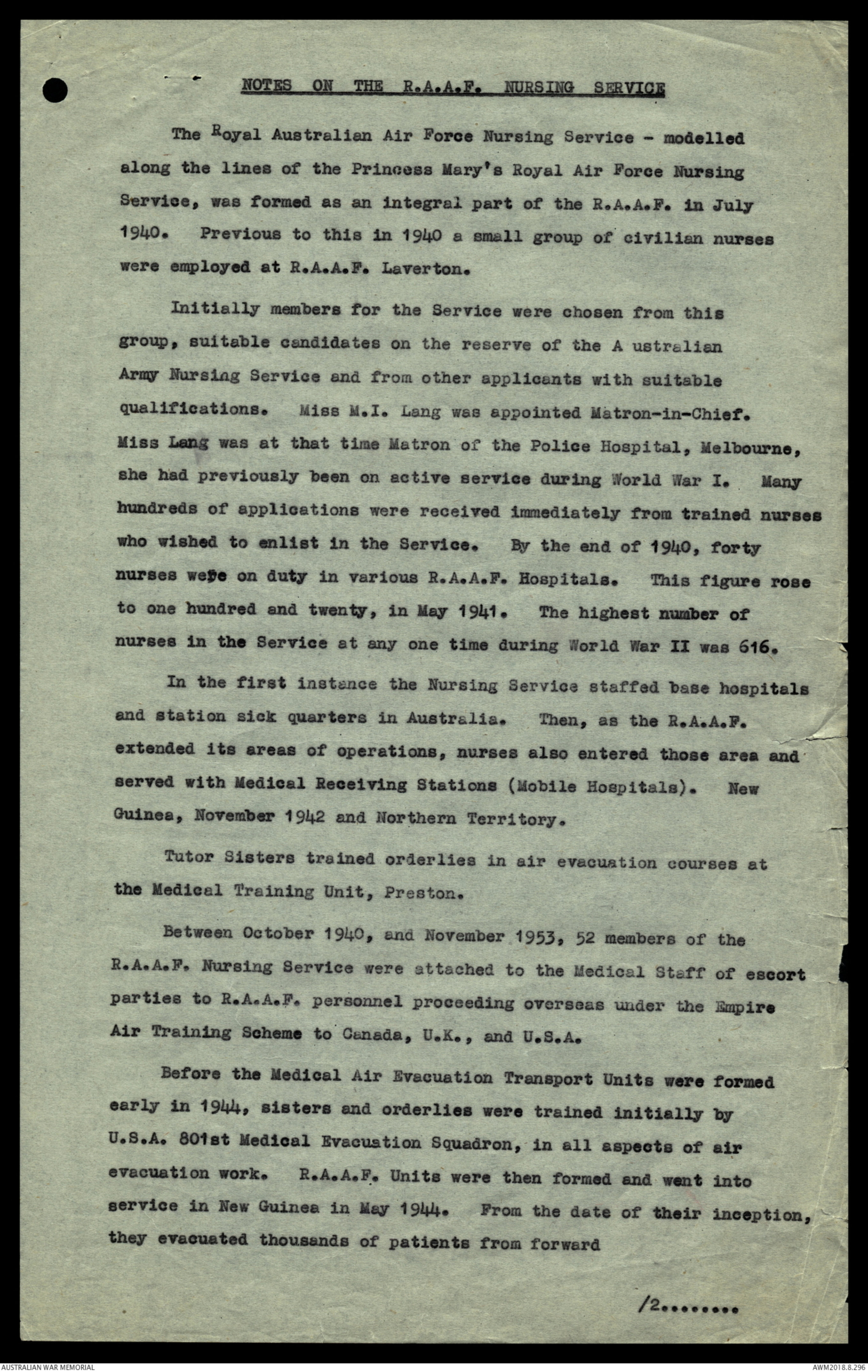

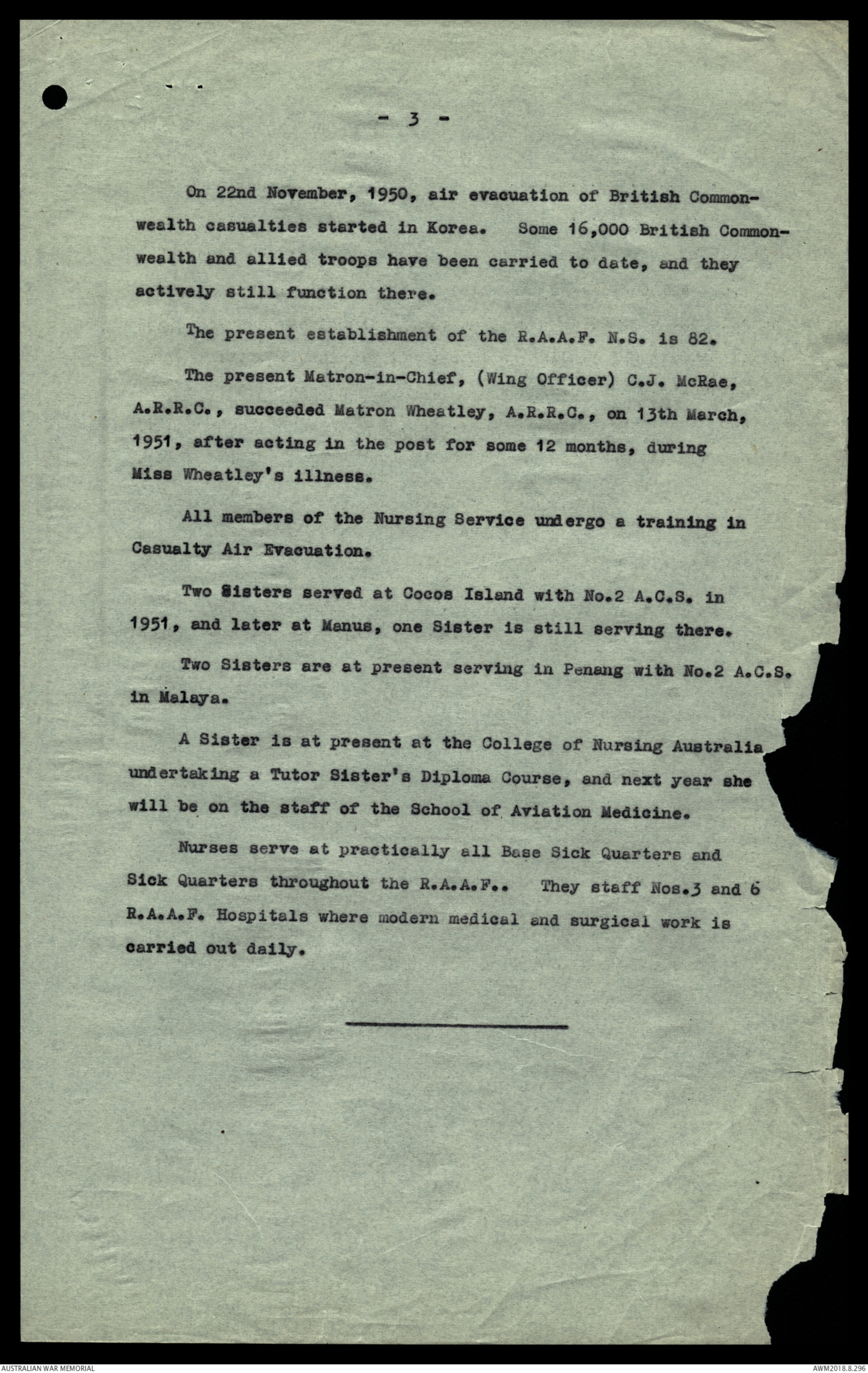
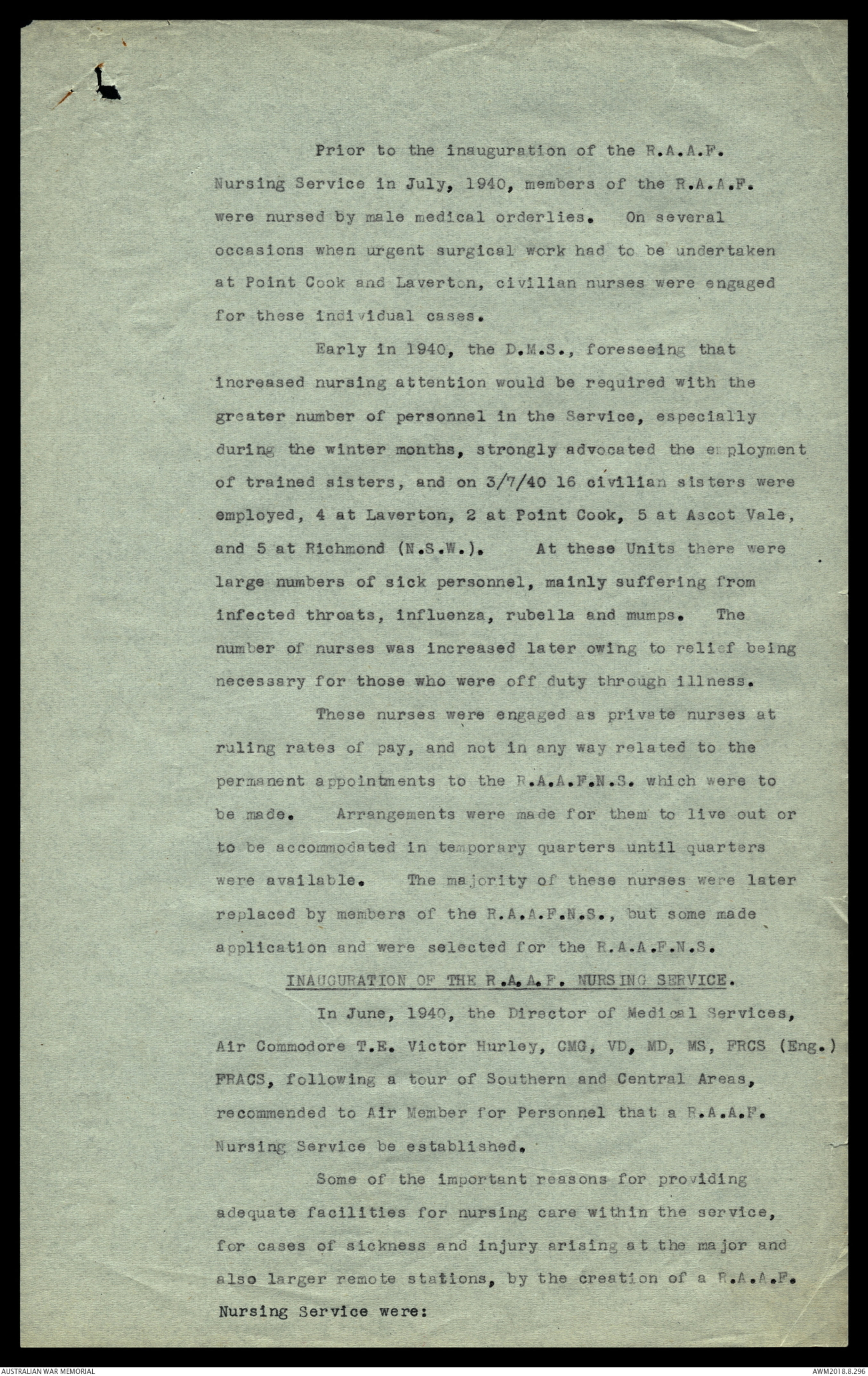
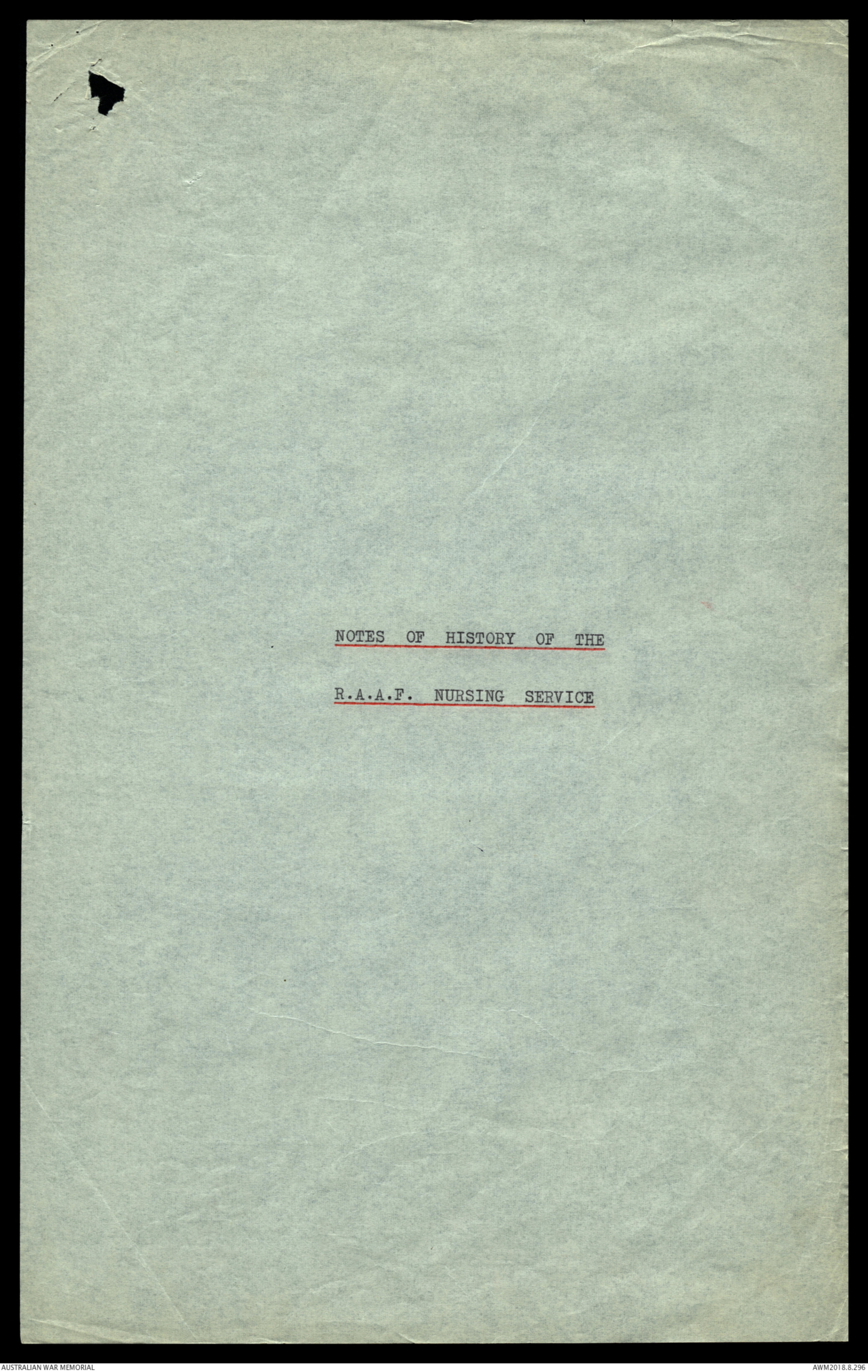
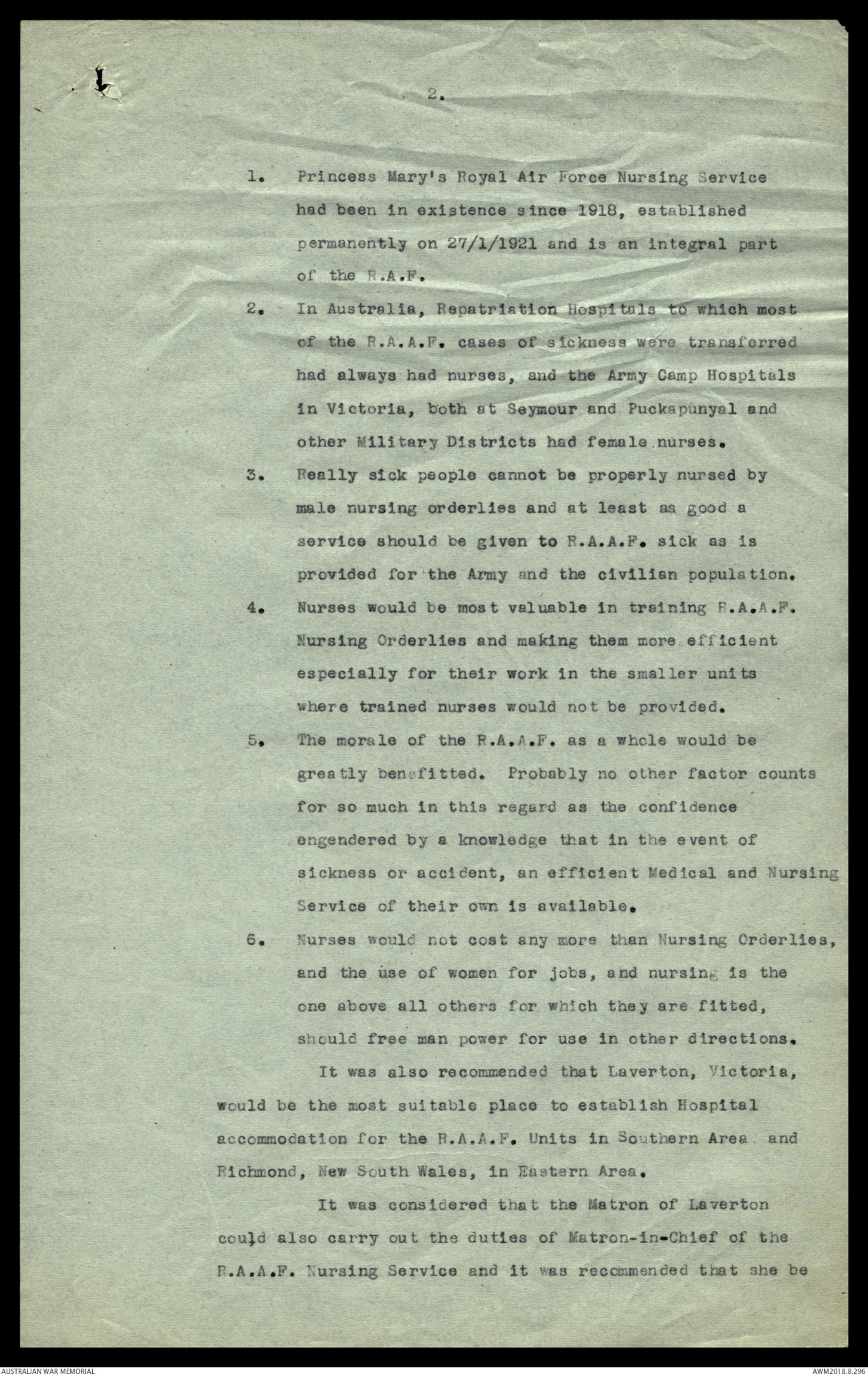

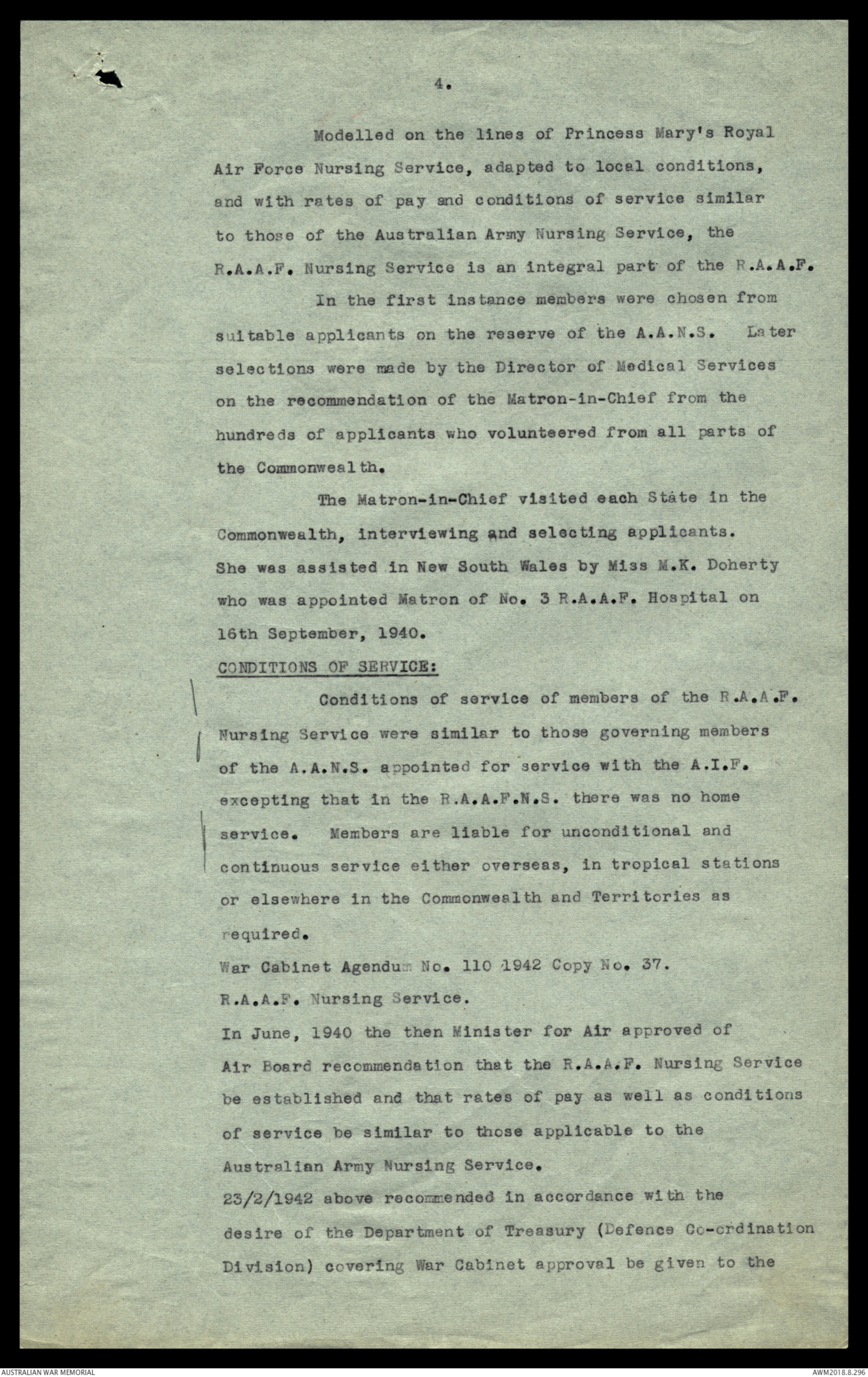
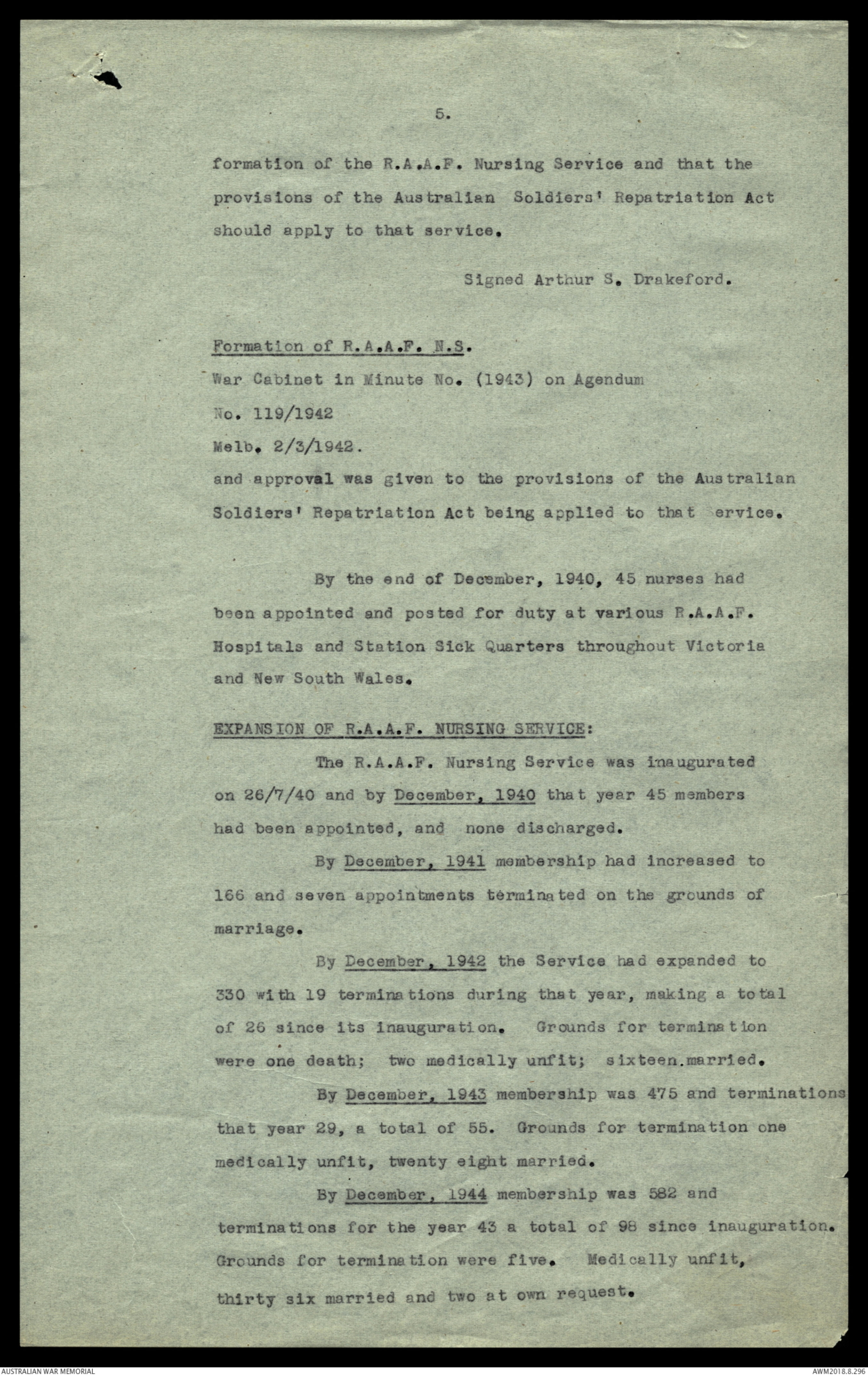
2.
The conditions of appointment to the Service were the
same as they are today, and all nurses were enlisted for overseas
service.
The uniform has altered since the formation of the
Service. White indoor nursing frocks were impracticable in the
forward areas, and were clearly visible from the air. An
instruction was issued in March, 1942, that all white uniforms
were to be dyed drab.
The early ranks held by the R.A.A.F. Nursing Service
were -
Staff Nurse
Sister
Senior Sister
Principal Matron
Matron-In-Chief
Recieved RAAFNS COMMISSIONS 1943
Later, these ranks were abolished, and, as you know,
today our ranks are the same as the Princess Mary's Royal Air Force
Nursing Service.
Membership of R.A.A.F. Nursing Service increased from
forty-five members in December, 1940, to 616 in December, 1945.
R.A.A.F. Nursing Sisters served at R.A.A.F. Hospitals
and Station Sick Quarters throughout Australia, with Medical
Receiving Stations in Operational Areas. They also served in
the Medical Air Evacuation Transport Units which flew into
forward areas to bring out casualties.
Two Sisters of the Medical Transport Unit lost their
lives on duty as the result of aircraft accidents.
Sister Marie Eileen Craig lost her life when the
aircraft in which she was flying with wounded personnel between
Biak and Merauke in Dutch New Guinea crashed on 18th September 1945.
Sister Verdun Bernice Sheah was reported killed in
an aircraft accident on 15th November, 1945, while flying wounded
Service personnel from Jacquinot Bay to Rabaul.
With the cessation of hostilities, plans were made
for demobilisation. This was arranged on point system; Sisters
were given three points for each year of age on enlistment, plus
one point for each month of service.
In September, 1948, a Permanent Air Force Nursing Service
was formed. The Nursing of R.A.A.F. personnel in the period
between the end of hostilities, which saw the beginning of
demobilisation, also the occupation of Japan, was performed
by the Sisters who volunteered to serve in the Interim Air Force.
A number of these Sisters were later appointed to a Permanent
Commission, and are still serving today.
NOTES ON THE R.A.A.F. NURSING SERVICE
The Royal Australian Air Force Nursing Service - modelled
along the lines of the Princess Mary's Royal Air Force Nursing
Service, was formed as an integral part of the R.A.A.F. in July
1940. Previous to this in 1940 a small group of civilian nurses
were employed at R.A.A.F. Laverton.
Initially members for the Service were chosen from this
group, suitable candidates on the reserve of the A ustralian
Army Nursing Service and from other applicants with suitable
qualifications. Miss M.I. Lang was appointed Matron-in-Chief.
Miss Lang was at that time Matron of the Police Hospital, Melbourne,
she had previously been on active service during World War I. Many
hundreds of applications were received immediately from trained nurses
who wished to enlist in the Service. By the end of 1940, forty
nurses were on duty in various R.A.A.F. Hospitals. This figure rose
to one hundred and twenty, in May 1941. The highest number of
nurses in the Service at any one time during World War II was 616.
In the first instance the Nursing Service staffed base hospitals
and station sick quarters in Australia. Then, as the R.A.A.F.
extended it's areas of operations, nurses also entered those area and
served with Medical Receiving Stations (Mobile Hospitals). New
Guinea, November 1942 and Northern Territory.
Tutor Sisters trained orderlies in air evacuation courses at
the Medical Training Unit, Preston.
Between October 1940, and November 1953, 52 members of the
R.A.A.F. Nursing Service were attached to the Medical Staff of escort
parties to R.A.A.F. personnel proceeding overseas under the Empire
Air Training Scheme to Canada, U.K., and U.S.A.
Before the Medical Air Evacuation Transport Units were formed
early in 1944, sisters and orderlies were trained initially by
U.S.A. 801st Medical Evacuation Squadron, in all aspects of air
evacuation work. R.A.A.F. Units were then formed and went into
service in New Guinea in May 1944. From the date of their inception,
they evacuated thousands of patients from forward
/2.........
- 2 -
areas to base hospitals. This work as been described as a
most gruelling and hazardous task for the R.A.A.F. Nurses.
On and after V.P. Day some thousands of P's.O.W. were evacuated
from wide areas.
August 15th, 1945, the official end of the Pacific War,
was really the beginning of a very arduous period for the Sisters
of the R.A.A.F. Medical Air Evacuation Units. They cared for in
flight 7,500 cases in 4 weeks. These girls tended liberated
prisoners of war out of Sumatra, Siam and Singapore. In one
airlift 2,000 persons were moved from Sumatra to Singapore in
five days.
Three One sisters taking part in this are still serving.
The area of operations reached in 1945 included New Guinea,
New Britain, Solomons, Morotai. R.A.A.F. Nurses arrived at
Borneo August 1945, working at the Medical Receiving Station,
Labuan Island.
Two Sisters lost their lives whilst serving with medical air
evacuation during the 1939-45 war, and three others died on
Service.
Principal Matron, Muriel Knox Doherty, R.R.C., was appointed
a matron of Belsen Germany in May 1945.
In November 1946, Miss Margaret Lang took discharge from
the R.A.A.F. Nursing Service after more than six years' service
as Matron-in-Chief. She was later awarded the O.B.E. for these
Services. She was succeeded by Matron A.J. Wheatley. The
service had by this time fallen to a strength of 120.
Three members proceeded to Japan with B.C.O.F. in February
1946, and three more at the end of 1946.
The first post war medical air evacuation course was
commenced on 26th April, 1949 such work up to then having been
carried out by war trained sisters.
/3.........
- 3 -
On 22nd November, 1950, air evacuation of British Commonwealth
casualties started in Korea. Some 16,000 British Commonwealth
and allied troops have been carried to date, and they
actively still function there.
The resent establishment of the R.A.A.F. N.S. is 82.
The present Matron-in-Chief, (Wing Officer) C.J. McRae,
A.R.R.C., succeeded Matron Wheatley, A.R.R.C., on 13th March,
1951, after acting in the post for some 12 months, during
Miss Wheatley's illness.
All members of the Nursing Service undergo a training in
Casualty Air Evaculation.
Two Sisters served at Cocos Island with No.2 A.C.S. in
1951 and later at Manus, one Sister is still serving there.
Two sisters are at present serving in Penang with No.2 A.C.S.
in Malaya.
A Sister is as present at the College of Nursing Australia
undertaking a Tutor Sister's Diploma Course, and next year she
will be on the staff of the School of Aviation Medicine.
Nurses serve at practically all Base Sick Quarters and
Sick Quarters throughout the R.A.A.F.. They staff Nos.3 and 6
R.A.A.F. Hospitals where modern medical and surgical work is
carried out daily.
____________________________________________
Prior to the inauguration of the R.A.A.F.
Nursing Service in July, 1940, members of the R.A.A.F.
were nursed by male medical orderlies. On several
occasions when urgent surgical work had to be undertaken
at Point Cook and Laverton, civilian nurses were engaged
for these individual cases.
Early in 1940, the D.M.S., foreseeing that
increased nursing attention would be required with the
greater number of personnel in the Service, especially
during the winter months, strongly advocated the employment
of trained sisters, and on 3/7/40 16 civilian sisters were
employed, 4 at Laverton, 2 at Point Cook, 5 at Ascot Vale,
and 5 at Richmond (N.S.W.). At these Units there were
large numbers of sick personnel, mainly suffering from
infected throats, influenza, rubella and mumps. The
number of nurses was increased later owing to relief being
necessary for those were off duty through illness.
These nurses were engaged as private nurses at
ruling rates of pay, and not in any way related to the
permanent appointments to the R.A.A.F.N.S. which were to
be made. Arrangements were made for them to live out or
to be accommodated in temporary quarters until quarters
were available. The majority of these nurses were later
replaced by members of the R.A.A.F.N.S., but some made
application and were selected for the R.A.A.F.N.S.
INAUGURATION OF THE R.A.A.F. NURSING SERVICE
In June, 1940, the Director of Medical Services,
Air Commodore T.E. Victor Hurley, CMG, VD, MD, MS, FRCS (Eng.)
FRACS, following a tour of Southern and Central Areas,
recommended to Air Member for Personnel that a R.A.A.F.
Nursing Service be established.
Some of the important reasons for providing
adequate facilities for nursing care within the service,
for cases of sickness and injury arising at the major and
also larger remote stations, be the creation of a R.A.A.F.
Nursing Service were:
NOTES OF HISTORY OF THE
R.A.A.F. NURSING SERVICE
2.
1. Princess Mary's Royal Air Force Nursing Service
had been in existence since 1918, established
permanently on 27/1/1921 and is an integral part
of the R.A.F.
2. In Australia, Repatriation Hospitals to which most
of the R.A.A.F. cases of sickness were transferred
had always had nurses, and the Army Camp Hospitals
in Victoria, both at Seymour and Puckapunyal and
other Military Districts had female nurses.
3. Really sick people cannot be properly nursed by
male nursing orderlies and at least as good a
service should be given to R.A.A.F. sick as is
provided for the Army and civilian population.
4. Nurses would be most valuable in training R.A.A.F.
Nursing Orderlies and making them more efficient
especially for their work in the smaller units
where trained nurses would not be provided.
5. The morale of the R.A.A.F. as a whole would be
greatly benefitted. Probably no other factor counts
for so much in this regard as the confidence
engendered by a knowledge that in the event of
sickness or accident, an efficient Medical and Nursing
Service of their own is available.
6. Nurses would not cost any more than Nursing Orderlies,
and the use of women for jobs, and nursing is the
one above all others for which they are fitted,
should free man power for use in other directions.
It was also recommended that Laverton, Victoria,
would be the most suitable place to establish Hospital
accommodation for the R.A.A.F. Units in Southern Area and
Richmond, New South Wales, in Eastern Area.
It is considered that the Matron of Laverton
could also carry out the duties of Matron-in-Chief of the
R.A.A.F. Nursing Service and it was recommended that she be
3.
appointed forthwith, so that the selection of nurses
for the Service could be undertaken. Actually the Matron
in Chief was not appointed Matron of Laverton but to
R.A.A.F. Headquarters on 26/7/1940.
The suggested provisional establishment for
nurses to be appointed was:-
Laverton (200 beds) 12 nurses initially - increasing to 20
Richmond (150 beds) 10 " " " 15
Pearce (100 beds) 6 " " " 10
1 ES. School
Vic. (100 beds) 6 " " " 10
Evans Head ( 40 beds) 4 " " " 6
It was considered at that time that R.A.A.F. nurses
might be necessary at (a) other Sick Quarters to be
established; (b) in any R.A.A.F. Sections of the large
Hospitals to be built for the three services; (c) R.A.A.F.
Convalescent Homes.
INAUGURATION :
On 28th June, 1940, the then Minister for Air
(Mr. Fairbairn) approved of Air Board recommendation that
the R.A.A.F. Nursing Service be established and that rates
of pay, as well as conditions of service be similar to
those applicable to the Army Nursing Service.
Mr. Fairbairn stated that the creation of the
R.A.A.F. Nursing Service was a logical development of the
expansion of the air arm.
The R.A.A.F. Nursing Service was established
on 26th July, 1940 with the appointment of the Matron-in-Chief,
Miss M.I. Lang, who served in World War 1 in
Salonika and who was, at the time of her appointment,
Matron of the Police Hospital Victoria. Miss Lang was
released from the Police Hospital and took up her duties
on 29th July, 1940 at R.A.A.F. Medical Directorate.
4.
Modelled on the lines of Princess Mary's Royal
Air Force Nursing Service, adapted to local conditions,
and with rates of pay and conditions of service similar
to those of the Australian Army Nursing Service, the
R.A.A.F. Nursing Service is an integral part of the R.A.A.F.
In the first instance members were chosen from
suitable applicants on the reserve of the A.A.N.S. Later
selections were made by the Director of Medical Services
on the recommendation of the Matron-in-Chief from the
hundreds of applicants who volunteered from all parts of
the Commonwealth.
The Matron-in-Chief visited each State in the
Commonwealth, interviewing and selecting applicants.
She was assisted in New South Wales by Miss M.K. Doherty
who was appointed Matron of No. 3 R.A.A.F. Hospital on
16th September, 1940.
CONDITIONS OF SERVICE:
Conditions of service of members of the R.A.A.F.
Nursing Service were similar to those governing members
of the A.A.N.S. appointed for the service with the A.I.F.
excepting that in the R.A.A.F.N.S. there was no home
service. Members are liable for unconditional and
continuous service either overseas, in tropical stations
or elsewhere in the Commonwealth and Territories as
required.
War Cabinet Agendum No. 110 1942 Copy No. 37.
R.A.A.F. Nursing Service.
In June, 1940 the then Minister for Air approved of
Air Board recommendation that the R.A.A.F. Nursing Service
be established and that rates of pay as well as conditions
of service be similar to those applicable to the
Australian Army Nursing Service.
23/2/1942 above recommended in accordance with the
desire of the Department of Treasury (Defence Co-ordination
Division) covering War Cabinet approval be given to the
5.
formation of the R.A.A.F. Nursing Service and that the
provisions of the Australian Soldiers' Repatriation Act
should apply to that service.
Signed Arthur S. Drakeford.
Formation of the R.A.A.F.N.S.
War Cabinet in Minute No. (1943) on Agendum
No. 119/1942
Melb. 2/3/1942.
and approval was given to the provisions of the Australian
Soldiers' Repatriation Act being applied to that ervice.
By the end of December, 1940, 45 nurses had
been appointed and posted for duty at various R.A.A.F.
Hospitals and Station Sick Quarters throughout Victoria
and New South Wales.
EXPANSION OF R.A.A.F. NURSING SERVICE:
The R.A.A.F. Nursing Service was inaugurated
on 26/7/40 and by December, 1940 that year 45 members
had been appointed, and none discharged.
By December, 1941 membership had increased to
166 and seven appointments terminated on the grounds of
marriage.
By December, 1942 the Service had expanded to
330 with 19 terminations during that year, making a total
of 26 since its inauguration. Grounds for termination
were one death; two medically unfit; sixteen married.
By December, 1943 membership was 475 and terminations
that year 29, a total of 55. Grounds for termination one
medically unfit, twenty eight married.
By December, 1944 membership was 582 and
terminations for the year 43 a total of 98 since inauguration.
Grounds for termination were five. Medically unfit,
thirty six married and two at own request.
 Not Yet Replaced By AI
Not Yet Replaced By AIThis transcription item is now locked to you for editing. To release the lock either Save your changes or Cancel.
This lock will be automatically released after 60 minutes of inactivity.